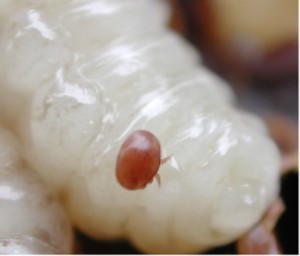Varroa destructor
Varroa destructor is a species of mite that is a significant pest of honey bees. Originating in Asia, Varroa destructor has spread to most regions worldwide where honey bees are kept. The mite is a major concern for beekeeping and wild bees due to its destructive impact on Apis mellifera (Western honey bee) colonies. This article provides an overview of Varroa destructor, including its biology, lifecycle, impact on bee colonies, and control measures.
Biology and Lifecycle
Varroa destructor mites are external parasites that feed on the bodily fluids of adult and developing bees. The lifecycle of Varroa destructor involves several stages, starting as an egg laid by a female mite on a bee larva. The egg hatches into a nymph, which then undergoes several molts before becoming an adult. Female mites are capable of reproducing multiple times, with each female laying several eggs on bee brood.
The mite prefers drone (male bee) brood for reproduction because drones have a longer developmental period than worker bees, providing the mite with more time to reproduce. However, Varroa destructor also infests worker brood, contributing to the spread and impact of the infestation within a colony.
Impact on Bee Colonies
Varroa destructor mites weaken bees by feeding on their fat bodies, an important organ that plays a role in immunity, detoxification, and energy storage. The feeding activity of the mites also spreads viruses, notably the Deformed Wing Virus (DWV), among bees. High levels of Varroa infestation can lead to colony collapse, characterized by a rapid decline in the bee population and eventually the death of the colony.
Control Measures
Managing Varroa destructor infestations is critical for the health of bee colonies. Control measures include chemical treatments, such as miticides, and mechanical methods, such as drone brood removal and screened bottom boards. Beekeepers also use integrated pest management (IPM) strategies to reduce mite populations while minimizing chemical use and its impact on bees.
Chemical treatments involve the application of substances like amitraz, fluvalinate, and oxalic acid to kill mites. However, mite resistance to some chemicals has been reported, highlighting the need for careful management and rotation of treatments.
Mechanical and cultural control methods aim to disrupt the mite's lifecycle or reduce its reproductive success. For example, removing drone brood, which attracts mites for reproduction, can help reduce the overall mite population in a colony.
Conclusion
Varroa destructor remains one of the most significant threats to honey bee health and beekeeping industries worldwide. Effective management of Varroa infestations is essential to maintain healthy bee colonies and ensure the sustainability of beekeeping and pollination services. Ongoing research into Varroa biology, its interaction with bee hosts, and control methods is crucial for developing new strategies to combat this pest.
Transform your life with W8MD's budget GLP-1 injections from $125.
W8MD offers a medical weight loss program to lose weight in Philadelphia. Our physician-supervised medical weight loss provides:
- Most insurances accepted or discounted self-pay rates. We will obtain insurance prior authorizations if needed.
- Generic GLP1 weight loss injections from $125 for the starting dose.
- Also offer prescription weight loss medications including Phentermine, Qsymia, Diethylpropion, Contrave etc.
NYC weight loss doctor appointments
Start your NYC weight loss journey today at our NYC medical weight loss and Philadelphia medical weight loss clinics.
- Call 718-946-5500 to lose weight in NYC or for medical weight loss in Philadelphia 215-676-2334.
- Tags:NYC medical weight loss, Philadelphia lose weight Zepbound NYC, Budget GLP1 weight loss injections, Wegovy Philadelphia, Wegovy NYC, Philadelphia medical weight loss, Brookly weight loss and Wegovy NYC
|
WikiMD's Wellness Encyclopedia |
| Let Food Be Thy Medicine Medicine Thy Food - Hippocrates |
Medical Disclaimer: WikiMD is not a substitute for professional medical advice. The information on WikiMD is provided as an information resource only, may be incorrect, outdated or misleading, and is not to be used or relied on for any diagnostic or treatment purposes. Please consult your health care provider before making any healthcare decisions or for guidance about a specific medical condition. WikiMD expressly disclaims responsibility, and shall have no liability, for any damages, loss, injury, or liability whatsoever suffered as a result of your reliance on the information contained in this site. By visiting this site you agree to the foregoing terms and conditions, which may from time to time be changed or supplemented by WikiMD. If you do not agree to the foregoing terms and conditions, you should not enter or use this site. See full disclaimer.
Credits:Most images are courtesy of Wikimedia commons, and templates, categories Wikipedia, licensed under CC BY SA or similar.
Contributors: Prab R. Tumpati, MD






